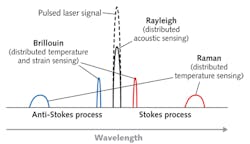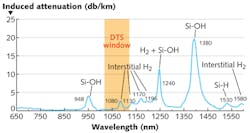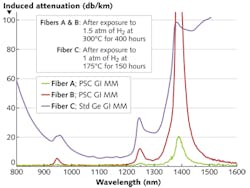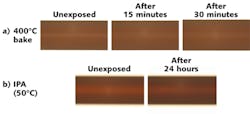Fiber for Remote Sensing: Downhole sensing applications enhanced by specialty optical fibers
GEORGE OULUNDSEN, DANIEL HENNESSEY, and MIKE CONROY
As the worldwide demand for energy increases, it becomes more important to efficiently extract and recover oil. In response, the oil industry continues to find new oil reservoirs and has developed enhanced extraction methods to recover oil from nontraditional wells such as shale oil (e.g. Eagle Ford and Bakken formations) and heavy oil sands (McMurray formation and the Orinoco Belt). In addition, only about a third of the potential oil is recovered from existing reservoirs, and enhanced oil recovery methods could increase the production of existing wells.1 Enhanced oil recovery methods have required new technologies for the continuous monitoring and optimization of the recovery process.
These enhanced oil recovery methods typically include cyclic steam stimulation (CSS) and steam assisted gravity drainage (SAGD).2,3 In both SAGD and CSS, the use of high-temperature steam (often along with other fluids) is used to heat and reduce the viscosity of the oil, improving flow and facilitating extraction to the surface. Efficient operation and optimization of the recovery process requires continuous process feedback.
Continuous monitoring of the well-temperature profile is important for optimal operation of the well. However, extremely harsh conditions found in oil wells complicate the measurement and monitoring of the downhole environment. As an example, in SAGD and CSS wells, the temperatures typically reach 200-350°C; pressures can reach 5000 psi; and the wells can contain high levels of hydrogen with partial pressures reaching 1–2 atmospheres (atm).
The high temperatures and harsh environmental conditions in oil wells challenge traditional electrical-based temperature sensors. In addition, traditional temperature sensors only give discrete local temperature values and usually cannot be left in the well for continuous process feedback. Starting in the 1990s, as enhanced oil recovery methods became more prevalent, the oil industry started experimenting with fiber optic sensors to overcome the challenges of traditional sensors.
One of the first types of fiber optic sensors developed for oil-well monitoring was a temperature sensor based on distributed temperature sensing (DTS), where the optical fiber is the sensor. Today, DTS is gaining significant popularity for continuous temperature monitoring in oil wells and it has become a valuable tool for optimizing and improving the operation and efficiency of oil recovery. Additional sensing technologies using optical fibers include distributed strain sensing (DSS) and distributed acoustic sensing (DAS), and the combination of temperature and strain called distributed temperature and strain sensing (DTSS). In all cases, the optical fiber is the sensor element.
The fiber is the sensor
Optical fiber-based distributed sensing is based on monitoring changes to the intrinsic properties of the light within the fiber when it is exposed to environmental changes, such as temperature or pressure. All of the distributed sensing methods presented here are based on light scattering and optical time-domain reflectometer (OTDR) technology. The three types of light scattering used in distributed sensing applications are Rayleigh, Brillouin, and Raman scattering. Figure 1 summarizes the three different scattering effects.
Each type of scattering phenomenon offers advantages and disadvantages for distributed sensing:
- Rayleigh scattering is elastic, that is, the scattered photon has the same energy as the signal photon, and therefore occurs at the same wavelength as the light signal. Of the three scattering effects, Rayleigh provides the strongest scattering absorption signal. Most DAS systems, where the signal-to-noise ratio (SNR) is very important, are based on Rayleigh scattering.
- Brillouin scattering is an inelastic scattering process involving the interaction of photons with acoustic phonons. In Brillouin scattering, the intensity and frequency of the Stokes (red-shifted) and Anti-Stokes (blue-shifted) signals depend on temperature and strain. The wavelengths of the Brillouin Stokes and Anti-Stokes peaks occur close to the input signal, so sophisticated filtering methods are needed to filter the Rayleigh signal and improve SNR. Since Brillouin scattering is both temperature- and strain-dependent, most DTSS systems are based on Brillouin scattering.
- Raman scattering is an inelastic scattering process involving the interaction of photons with molecular vibrational and rotational transitions. The intensity ratio of the Raman Stokes (temperature-insensitive) to the Anti-Stokes (temperature-dependent) peaks depends on temperature. The large wavelength separation between the Raman Stokes and Anti-Stokes peaks makes it easy to filter the Rayleigh scattering and achieve good SNR. Because of the ease of filtering noise and the insensitivity to strain, most DTS systems are based on Raman scattering. However, the signal intensity from Raman scattering is the weakest of the three scattering processes. To increase the Raman signal intensity, it is necessary to use higher-input pulse signals, and therefore multimode fibers are preferred over single-mode fibers for Raman-based DTS systems.
In all three distributed sensing technologies, the system configuration is similar. A laser source is used to launch a pulse of signal light into the sensing optical fiber. As the light pulse travels along the length of the fiber, a small amount of the signal is backscattered by Rayleigh, Brillouin, and/or Raman scattering effects. The backscattered light is filtered for the specific wavelengths and is analyzed to determine the temperature and/or strain. A spectrum of the backscattered light can be generated along the entire length of the fiber and, based on the time of flight, the temperatures and/or strains are correlated to the spatial position in the fiber.
The light propagating in the sensing fiber and the resulting backscattering is very responsive to environmental changes and, therefore, optical fiber sensors are extremely sensitive and can provide very fine spatial resolution along the fiber length. For example, today's typical DTS systems can determine temperatures with a spatial resolution of 1 m (some high-end systems can achieve 20–30 cm resolution) and an accuracy of ±0.5 to 1°C with a resolution of 0.01°C.
This is important because oil well operators will optimize and change the operation of the well based on small temperature changes on the order of a few degrees Celsius. Additionally, due to the low loss of optical fibers, distributed sensing over tens of kilometers (as many as 50 km) is possible depending on the type of sensing and environment. The long lengths are essential since oil wells can be several kilometers deep and some double-ended sensing deployments require the fiber to loop back, necessitating fiber lengths up to 10 km.
Fibers for downhole sensing applications
All three of the distributed sensing technologies are used by the oil industry, but the most widely deployed is Raman-based DTS, especially for downhole temperature measurements. To present the most comprehensive example, we focus on optical fibers for realizing an operational Raman-DTS system for high-temperature enhanced oil recovery wells.
This requires specialty optical fibers in which both the glass design and the fiber coating are capable of operating at high temperatures (up to 300°C) and in typical oil well environments for long periods of time. At such high temperatures and in the presence of hydrogen, most optical fibers will degrade rapidly, becoming highly attenuated (dark). Therefore, the overall fiber design and the manner in which the fiber is manufactured become important considerations for high-temperature downhole applications.
Also, the SNR is critical in DTS, and it is imperative the Raman scattering Stokes and Anti-Stokes signals are not compromised by interference from absorption peaks related to interstitial hydrogen and reactive hydrogen bonds. Figure 2 summarizes the absorption peaks attributed to interstitial hydrogen and reactive hydrogen bonds (Si-O-H and Si-H).4Molecular hydrogen can diffuse into the fiber and occupy interstitial sites that have specific absorption peaks. Once removed from the hydrogen enviroment, the dissolved hydrogen can diffuse out and hence these losses are reversible. Absorption peaks can also form when hydrogen reacts with the Si or Si-O in the fiber, creating Si-H or Si-O-H bonds. This often happens at defect sites in the fiber where the oxygen atoms are not fully bonded. In Ge-doped fibers, there are broad induced losses as hydrogen reacts with Ge-defect sites at both short (<900 nm) and long wavelengths (>1400 nm), as well as losses associated with Ge-OH formation (1410 nm).5 The induced attenuation from the -H and -OH bonds are irreversible and permanent.
The typical operating window for Raman DTS is also shown in Figure 2. The key wavelengths for Raman DTS are the signal wavelength (1064 nm) and the wavelengths of the Anti-Stokes (1014 nm) and Stokes (1114 nm) processes. Sensing fibers must exhibit minimal losses at these wavelengths in the downhole environment. The challenge is designing an optical fiber that has very low losses in the presence of hydrogen partial pressures of 1–2 atm at temperatures of up to 300°C or more.
There are two methods of designing fibers with low loss in hydrogen-rich environments. One method is coating the fiber with a hermetic coating, the most common of which is carbon. Layers of carbon in the form of randomly orientated carbon platelets can be applied to optical fibers during the fiber draw process.5 The carbon layer is much less permeable to hydrogen than other coating materials, so the rate of hydrogen diffusion into the fiber is significantly reduced.
However, there are two disadvantages of this approach: (1) over time, the hydrogen will diffuse through the carbon layer and reach the fiber core; and (2) at elevated temperatures (>170°C), the carbon coating becomes permeable to hydrogen, losing its hermeticity. Carbon-coated fibers are primarily used for downhole environments where the temperature is <170°C.
The alternative method involves designing the core of the fiber to be much less sensitive to hydrogen-induced losses. This approach can significantly reduce the impact of the Si-H and Si-OH absorption peaks, but interstitial hydrogen-induced losses will still occur. The key is managing the losses at the wavelengths of interest so the DTS system will function normally. The advantage of this approach is that with the proper fiber coating, such as polyimide, the fibers can operate up to 300°C with very little signal degradation at the relevant wavelengths.
The ideal Raman DTS fiber design for high-temperature (up to 300°C), hydrogen-rich environments is graded-index 50/125 μm multimode fibers with polyimide coating. These fibers, referred to as pure silica core (PSC) fibers, have fluorine as the only dopant. They are designed with a heavily fluorine-doped cladding region for 0.2 NA and a fluorine-doped silica parabolic graded-index core region.
Controlling the smooth graded-index profile in these fibers is very challenging but essential since the spatial resolution of the sensor is defined by the bandwidth. Step index multimode fibers do not have sufficient bandwidth to provide the necessary spatial resolution. The preferred spatial resolution is 1 m and requires bandwidths of 300 MHz-km at 850 and 1300 nm.
Figure 3 shows the induced attenuation for three different fibers after exposure to hydrogen. Fiber A is Nufern's PSC graded-index multimode fiber (NuSENSOR GR-S50/125-20P), and Fiber B is another commercially available PSC graded-index multimode fiber-both are designed for high-temperature, hydrogen-rich downhole environments. Fiber C is a standard graded-index 50/125 multimode fiber used in the telecommunication industry.In Figure 3, the two specifically designed fibers (A and B) exhibit much lower induced attenuation when exposed to a high-temperature hydrogen atmosphere, especially in the 1000–1120nm range used in Raman DTS. The standard 50/125 Ge-doped fiber experiences significantly higher hydrogen-induced losses and would not work in downhole sensing applications.
In addition to the fiber design, processing conditions can also determine how well a fiber performs in the presence of hydrogen. Fibers A and B are commercially available from different suppliers and are made with different processes. They are both pure silica core, graded-index 50/125 multimode fibers with 0.2 NA and designed for high-temperature downhole Raman DTS. Figure 3 demonstrates the defect sites leading to the formation of Si-OH bonds present in Fiber B are much greater than in Fiber A.
As mentioned, the induced losses associated with Si-H and Si-OH formation are permanent. Both fibers will work well at the standard wavelength range (1000 to 1120 nm) used for Raman DTS, but clearly Fiber A will perform better at other wavelengths. Operating at different wavelengths may become important in the future as the oil industry explores and develops new technologies. For example, the 1310 and 1550 nm wavelengths usually associated with SM fiber operation may be utilized in applications requiring these specialty multimode fibers.
Critical coating tests
As important as the robustness of the glass in the fiber, the fiber coating must also continue to operate under the same harsh conditions. The fiber coating of choice for up to 300°C operation is polyimide. Not all polyimides are the same so the actual material selection and the manner in which the coating is applied must be considered. Testing the fiber coating can be done in many different ways.
The two critical coating tests are high-temperature performance and chemical resistance. Performing a high-temperature bake demonstrates coating performance at elevated temperatures and can help determine if the coating is sufficiently cured. If the coating is under-cured, blistering will occur at elevated temperatures. Under-cured coatings do not sufficiently protect the glass and often lack the chemical resistance required in downhole environments. Figure 4 gives examples of under-cured, poorly optimized polyimide coating where blistering is prevalent after baking at 400°C.Another critical test is the chemical resistance of the coating. In the oil industry, the fiber can be exposed to several types of solvents. One such solvent is isopropyl alcohol (IPA), sometimes used when the fiber is pumped into oil wells. Figure 5 shows before and after microscope images of optimized polyimide fibers during a 400°C bake and exposed to 50°C IPA.
Figure 5 demonstrates a properly designed fiber coating can withstand both elevated temperatures and exposure to IPA. Testing for specific chemical resistance as it relates to the final application is important. Not all fibers that pass high-temperature bake tests perform well upon exposure to a specific chemical, such as IPA. Therefore, both sets of tests should be performed, as shown in Figure 5. Additional testing for chemical resistance against other solvents is prudent. As shown in Figure 5, the fiber coating after exposure to 400°C shows no signs of deterioration or damage. Both coating material selection and draw process optimization are critical to achieve a robust coating for harsh environments.
Meeting the challenges
Traditional measurement devices are significantly challenged by the high temperatures and harsh environments found in many oil wells-especially those using enhanced oil recovery technologies such as CSS or SAGD. Distributed sensing methods using optical fibers have become valuable tools providing critical process feedback for monitoring the entire wellbore.
Advanced sensing technologies such as DTS have required the development of specially designed fibers to withstand the harsh downhole environments. These specialty fibers have been commercially available for several years, but today's fibers perform much better than previous generations and can provide many years of service even in hydrogen-rich environments at temperatures up to 300°C. Fiber optic sensors will become more prevalent in downhole applications as the demand for improved measurement and monitoring capabilities continues.
References
1. R.C. Ferguson, et al., "Storing CO2 with enhanced oil recovery," Energy Procedia 1, 1989–1996 (2009).
2. J. Alvarez and S. Han, "Current overview of cyclic steam injection process," J. Pet. Sci. Res. 2(3), 116–127 (July 2013).
3. S.Q. Tunio, et al., "Comparison of different enhanced oil recovery techniques for better oil productivity," Int. J. Appl. Sci. Technol. 1(5), 143–153 (September 2011).
4. O. Humbach, et al., "Analysis of OH absorption bands in synthetic silica," J. Non-Cryst. Solids 203, 19–26 (1996).
5. A. Mendez and T.F. Morse, "Hermetic optical fibers: Carbon-coated fibers," Chapter 14 in Specialty Optical Fibers Handbook, Lemaire and Lindholm (Academic Press, 2007), 453.
George Oulundsen is fiber product line manager at Nufern. Daniel Hennessey is technical manager and Mike Conroy is test engineer in the Fiber R&D Group at Nufern, 7 Airport Park Rd., East Granby, CT; email: [email protected]; www.nufern.com.




